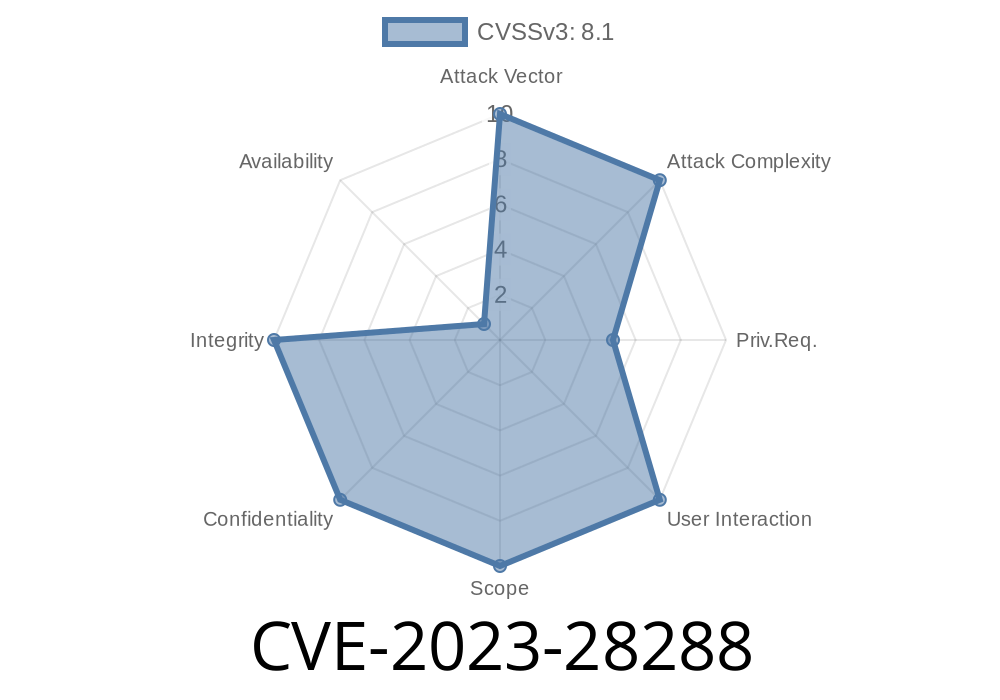In the world of cybersecurity, vulnerabilities and exploits are always a cause of concern. Today, we take a closer look at the Microsoft SharePoint Server Spoofing Vulnerability, which has been assigned the reference CVE-2023-28288. This may seem like just another exploit, but it's essential to keep information up-to-date and address these vulnerabilities as they arise. In this post, we'll delve into the details of this particular vulnerability, provide a code snippet, and link to original references, all in simple American language to make this read exclusive and informative.
Vulnerability Description
CVE-2023-28288 is a security vulnerability that affects Microsoft SharePoint Server. It is classified as a spoofing vulnerability, which allows an attacker to deceive or trick the victims by impersonating another user or process. This type of attack can lead to unauthorized access to sensitive information or unauthorized modification of data. The vulnerability occurs when the server fails to validate the source markup of a request, enabling a malicious actor to potentially exploit this weakness. This vulnerability affects Microsoft SharePoint Server versions 2019 and 2021.
Exploit Details
The exploit details for CVE-2023-28288 involve the attacker crafting a malicious HTTP request, which may contain false data or harmful code. The attacker sends this request to the Microsoft SharePoint Server, which does not correctly validate the source markup of the request. As a result, the attacker is able to execute any desired actions on the server, including extracting sensitive information, elevating privileges, or manipulating data.
An example of a malicious HTTP request is shown below
POST /_api/web/lists/GetByTitle('CVE-2023-28288') HTTP/1.1
Host: target.sharepoint.com
Content-Type: application/json;odata=verbose
Accept: application/json;odata=verbose
{
"BaseTemplateID": 101,
"AllowContentTypes": true,
"ContentTypesEnabled": true,
"Description": "<script>alert('Spoofing Vulnerability!')</script>"
}
Here, the attacker sends a POST request to the SharePoint Server API, allowing the creation of a list with a malicious Description containing a script. SharePoint Server does not validate the source markup properly, allowing the attacker to potentially inject harmful code or extract sensitive information.
Original References
1. Microsoft Security Update Guide - CVE-2023-28288
2. National Vulnerability Database - CVE-2023-28288
To help understand and fix this vulnerability, refer to the official Microsoft Security Update Guide. Microsoft has released a patch to address CVE-2023-28288, which is recommended to be installed promptly in order to secure your SharePoint Server installation.
Conclusion
CVE-2023-28288 is a spoofing vulnerability with the potential to put sensitive information at risk and allow unauthorized access to your Microsoft SharePoint Server. In this exclusive post, we have simplified the details of this exploit to make it accessible to all readers. With a better understanding of the vulnerability, it's essential to keep your SharePoint Server updated and secure.
It's crucial to always stay updated on the latest vulnerabilities and exploit details to be better prepared to protect your systems. Installing the recommended patches and keeping up with cybersecurity best practices will help you maintain the security of your organization's information assets.
Timeline
Published on: 04/11/2023 21:15:00 UTC
Last modified on: 06/17/2023 01:15:00 UTC
